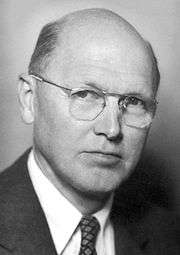Dickinson W. Richards
| Dickinson W. Richards | |
|---|---|
|
Dickinson W. Richards | |
| Born |
Dickinson Woodruff Richards, Jr. October 30, 1895 Orange, New Jersey |
| Died |
February 23, 1973 (aged 77) Lakeville, Connecticut |
| Nationality | American |
| Fields |
medicine physiology |
| Institutions |
Columbia University Bellevue Hospital Presbyterian Hospital |
| Alma mater |
Yale University Columbia University College of Physicians and Surgeons |
| Known for | cardiac catheterization |
| Notable awards | Nobel Prize in Physiology or Medicine in 1956 |
Dickinson Woodruff Richards, Jr. (October 30, 1895 – February 23, 1973) was an American physician and physiologist. He was a co-recipient of the Nobel Prize in Physiology or Medicine in 1956 with André Cournand and Werner Forssmann for the development of cardiac catheterization and the characterisation of a number of cardiac diseases.
Early life
Richards was born in Orange, New Jersey. He was educated at the Hotchkiss School in Connecticut, and entered Yale University in 1913. At Yale he studied English and Greek, graduating in 1917 as a member of the senior society Scroll and Key.
Career
He joined the United States Army in 1917, and became an artillery instructor. He served from 1918–1919 as an artillery officer in France.
When he returned to the United States, Richards attended Columbia University College of Physicians and Surgeons, graduating with an M.A. in 1922 and his M.D. degree in 1923. He was on the staff of the Presbyterian Hospital in New York until 1927, when he went to England to work at the National Institute for Medical Research in London, under Sir Henry Dale, on the control of circulation in the liver.
In 1928 Richards returned to the Presbyterian Hospital and began his research on pulmonary and circulatory physiology, working under Professor Lawrence Henderson of Harvard. He began collaborations with André Cournand at Bellevue Hospital, New York, working on pulmonary function. Initially their research focussed on methods to study pulmonary function in patients with pulmonary disease.
Their next area of research was the development of a technique for catheterization of the heart. Using this technique they were able to study and characterise traumatic shock, the physiology of heart failure. They measured the effects of cardiac drugs, and described various forms of dysfunction in chronic cardiac diseases and pulmonary diseases and their treatment, and developed techniques for the diagnosis of congenital heart diseases. For this work, André Cournand and Werner Forssmann, were awarded the Nobel Prize for Physiology or Medicine for 1956.
In 1945 Richards moved his lab to Bellevue Hospital, New York. In 1947 he was made the Lambert Professor of Medicine at Columbia University, where he had taught since 1925. During his career he also served as an advisor to Merck Sharp and Dohme Company, and edited the Merck Manual. Richards retired from his positions at Bellevue and Columbia in 1961.
Honor
Richards received many other honors, including the John Phillips Memorial Award of the American College of Physicians in 1960, the Chevalier de la Legion d'Honneur in 1963, the Trudeau Medal in 1968, and the Kober Medal of the Association of American Physicians in 1970.
He died in Lakeville, Connecticut.
References
- Fishman, Alfred P. Richards, Dickinson Woodruff. American National Biography Online February 2000.
- Nobel Lectures, Physiology or Medicine 1942–1962, Dickinson W. Richards, Elsevier Publishing Company, Amsterdam, 1964
- Ventura, Hector O (August 2007). "Dickinson Woodruff Richards and cardiac catheterization". Clinical cardiology. 30 (8): 420–1. doi:10.1002/clc.20093. PMID 17680601.
- Chamberlin, M D (February 2001). "Dickinson W. Richards, MD: through a grand-daughter's eyes". Coron. Artery Dis. 12 (1): 79–82. doi:10.1097/00019501-200102000-00012. PMID 11211171.
- Raju, T N (May 1999). "The Nobel chronicles. 1956: Werner Forssmann (1904–79); André Frédéric Cournand (1895–1988); and Dickinson Woodruff Richards, Jr (1895–1973)". Lancet. 353 (9167): 1891. doi:10.1016/S0140-6736(05)75106-0. PMID 10359453.
- Cournand, A (1989). "Dickinson Woodruff Richards: October 30, 1895 – February 23, 1973". Biographical memoirs. National Academy of Sciences (U.S.). 58: 459–87. PMID 11616152.
- Carroll, D G (1975). "Memorial. Dickinson W. Richards, M.D". Trans. Am. Clin. Climatol. Assoc. 86: XLIII–XLIV. PMC 2441343
 . PMID 1101509.
. PMID 1101509. - "Dickinson Woodruff Richards". Lancet. 1 (7805): 732–3. March 1973. doi:10.1016/s0140-6736(73)91532-8. PMID 4120541.
- Cournand, A (1973). "Dickinson Woodruff Richards, 1895–1973". Trans. Assoc. Am. Physicians. 86: 33–8. PMID 4596458.
- Kenéz, J (November 1970). "[Dickinson Woodruff Richards and cor pulmonale]". Orvosi hetilap. 111 (48): 2849–52. PMID 4923281.
- Cournand, A F (1970). "Presentation of the Kober Medal for 1970 to Dickinson W. Richards". Trans. Assoc. Am. Physicians. 83: 36–42. PMID 4927298.
- Sulek, K (January 1969). "[Nobel prize for Andre F. Cournand, Werner T. O. Forssmann and Dickinson W. Richards in 1956 for the discovery related to heart catheterization and studies on pathological changes in the cardiovascular system]". Wiad. Lek. 22 (2): 203–4. PMID 4890192.
